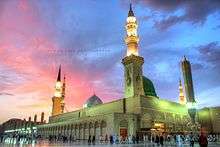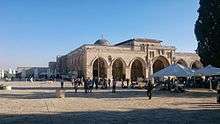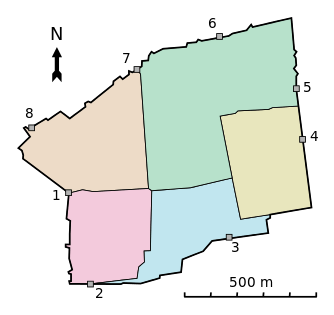Holiest sites in Islam
There are sites, which are mentioned or referred to in the Quran, that are considered holy to Islam.[1] Mecca[2] and Medina[3][4][5] are the two holiest cities in Islam, unanimous among all sects.[6] In the Islamic tradition, the Kaaba in Mecca is considered the holiest site, followed by the Prophet's Mosque in Medina. Additionally, Al-Aqsa Mosque in the Old City of Jerusalem and the Sanctuary of Abraham (Ibrahimi Mosque) in Hebron are also quite significant,[1] being the third and fourth holiest sites in Sunni Islam,[7][8][9][10][11] and one of the holiest sites in Shi'ite tradition.
Hijaz

The Hejaz (Arabic: ٱلْـحِـجَـاز, translit. Al-Ḥijāz) is the region in the Arabian peninsula where Mecca and Medina are located. It is thus where the Muhammad was from.[12]
Mecca
Mecca[1] is considered the holiest city in Islam, as it is home to the Ka‘bah (Arabic: كَـعْـبَـة, 'Cube') and Al-Masjid Al-Ḥarām (Arabic: ٱلْـمَـسْـجِـد الـحَـرَام,[2] "The Sacred Place-of-Propstration"). Only Muslims are allowed to enter this place.[13]
The area of Mecca, which includes Arafah,[14] Mina and Muzdalifah, is important for the Ḥajj (Arabic: حَـجّ, 'Pilgrimage'). As one of the Five Pillars of Islam,[15] every adult Muslim who is capable must perform the Hajj at least once in their lifetime.[16] Hajj is one of the largest annual Muslim gatherings in the world, second only to pilgrimages to the Mosques of Imam Husayn and Abbas in Karbala, Iraq, with attendance reaching 3 million in 2012.[17]
Medina
Al-Masjid An-Nabawiyy (Arabic: ٱلْـمَـسْـجِـد الـنَّـبَـوِيّ, the Prophet's Mosque) is located in Medina, making the city the second-holiest site in Islam, after Mecca. Medina is the final place-of-residence of Muhammad, and where his qabr (Arabic: قَـبْـر, grave) is located.[6] In addition to the Prophet's Mosque, the city has the Mosques of Qubā’ (Arabic: قُـبَـاء)[18] and Al-Qiblaṫayn (Arabic: ٱلْـقِـبْـلَـتَـيْـن, "The Two Qiblahs").[19]
Shaam
Greater Syria (Arabic: ٱلـشَّـام, translit. Ash-Shām)[20] is a region that extends from Syria in the north to the area of Palestine in the south.[21][22] It includes the cities of Jerusalem and Hebron.[20]
Jerusalem
| Part of a series on |
| Jerusalem |
|---|
-Aerial-Jerusalem-Temple_Mount-Temple_Mount_(south_exposure).jpg) |
| Sieges |
| Places |
| Positions |
| Other topics |
|
|

According to mainstream Sunni and Shi'ite traditions, Al-Masjid Al-Aqṣā (Arabic: ٱلْـمَـسْـجِـد الْأَقْـصَى,[23] "The Farthest Place-of-Prostration") is located in Jerusalem. The mosque is held in esteem by the entire Muslim community, due to its history as a place of worship that is intertwined with the lives of many Biblical prophets, such as Abraham (who is also linked with the sanctuary of Mecca),[1] David, Solomon, Elijah and Jesus as well as for its special status. It comprises 144,000 m2 (1,550,000 sq ft) in size (covering approximately one-sixth of the entire area of the Old City of Jerusalem), and with the capacity to accommodate in the region of 500,000 worshipers.[24] The mosque was the first direction of prayer in Muhammad's lifetime, before the Kaaba in Mecca, and Muhammad was believed to have been taken by the miraculous steed, that is the Buraq, to visit Al-Aqsa Mosque, where he prayed, and was then taken to the heavens, in a single night in the year 620 CE that is known as Al-Isrā’ wal-Mi‘rāj (Arabic: ٱلْإِِسْـرَاء وَالْـمِـعْــرَاج, "The Night-Journey and the Ascension"). The mosque mentioned in the Quran has been understood to have been the remains of the Jewish Temple on the Temple Mount in Jerusalem, both by the people of 7th century Arabia, at the time of this verse's revelation, as well as the long tradition of Muslim scholars, throughout fourteen centuries of Islamic intellectual history. The land of Jerusalem is mentioned in the Quran as being "blessed" or "holy" on numerous occasions.[20] Below are Quranic references from Surah Al-Ma'idah (5),[25] Al-Isra' (17),[23] Al-Anbiya[26] and Saba (34):[27]
"O my people! Enter the holy land which Allah hath assigned unto you, and turn not back ignominiously, for then will ye be overthrown, to your own ruin."
— Qur'an, Surah 5 (Al-Ma'idah), Ayah 21.
"Glorified be He (Allah) Who did take His servant (Muhammad) for a journey by night from Al-Masjidil-Ḥarām to Al-Masjidil-Aqṣā, whose precincts We did bless, in order that We might show him some of our Signs. Verily He is the All-Hearing, All-Seeing.
...
If ye did well, ye did well for yourselves; if ye did evil, (ye did it) against yourselves. So when the second of the warnings came to pass, (We permitted your enemies) to disfigure your faces, and to enter the Masjid as they had entered it before, and to visit with destruction all that fell into their power."
— Qur'an, Surah 17 (Al-Isra'), Ayat 1 – 7.
"But we delivered him (Abraham) and Lot, and directed them to the land which we have blessed for the Worlds.
...
And for Solomon, We subjected the violent (unruly) wind flow (tamely) to his order, to the land which We had blessed: for We do know all things."
— Qur'an, Surah 21 (Al-Anbiya), Ayat 71 – 81.
"Between them (Sabaeans) and the qurā (Arabic: قُـرَى, townships) which We had blessed, We had placed townships in prominent positions, and between them We had appointed stages of journey in due proportion: "Travel therein, secure, by night and by day.""
— Qur'an, Surah 34 (Saba), Ayah 18.
It is specified in a ḥadīth (Arabic: حَـديْـث, saying attributed to Muhammad), that the Al-Masjid Al-Aqsa is indeed located in Jerusalem:
"That he heard Allah's Apostle saying, "When the people of Quraysh did not believe me (i.e. the story of my Night Journey), I stood up in Al-Hijr and Allah displayed Jerusalem in front of me, and I began describing it to them while I was looking at it."
And Ibn Abbas added:
"And the Prophets lived therein. There is not a single inch in Jerusalem where a Prophet has not prayed or an Angel not stood."
— At Tirmidhi.
Hebron
Hebron is a Palestinian city located in the southern West Bank, 30 km (19 mi) south of Jerusalem. Muslims venerate it for its association with Abraham – it includes the traditional burial site of the biblical Patriarchs and Matriarchs, within the Sanctuary of Abraham, also known as the Ibrahimi Mosque.[7][29][30][31][32]
Sinai peninsula
The Sinai peninsula is associated with Aaron and Moses, who are also regarded as Prophets.[33] In particular, numerous references to Mount Sinai exist in the Quran,[34][35] where it is called Ṭūr Sīnā’ (Arabic: طُـوْر سِـيْـنَـاء), Ṭūr Sīnīn (Arabic: طُـوْر سِـيْـنِـيْـن),[36] aṭ-Ṭūr (Arabic: ٱلـطُّـوْر, "the Mount"),[37][38] and al-Jabal (Arabic: ٱلـجَـبَـل, "the Mount").[39] As for the adjacent Wād Ṭuwā (Arabic: وَاد طُـوَى, Valley of Tuwa), it is considered as being muqaddas (Arabic: مُـقَـدَّس,[40][41] sacred),[42][43] and a part of it is called Al-Buq‘ah Al-Mubārakah (Arabic: ٱلْـبُـقْـعَـة الْـمُـبَـارَكَـة, "The Place the Blessed").[38]
See also
References
- 1 2 3 4 Michigan Consortium for Medieval and Early Modern Studies (1986). Goss, V. P.; Bornstein, C. V., eds. The Meeting of Two Worlds: Cultural Exchange Between East and West During the Period of the Crusades. 21. Medieval Institute Publications, Western Michigan University. p. 208. ISBN 0918720583.
- 1 2 Quran 48:22–29
- ↑ Quran 9:25–129
- ↑ Quran 33:09–73
- ↑ Quran 63:1–11
- 1 2 Trofimov, Yaroslav (2008), The Siege of Mecca: The 1979 Uprising at Islam's Holiest Shrine, New York, p. 79, ISBN 0-307-47290-6
- 1 2 ‘Ali (1991), p. 58
- ↑ Dumper 2003, p. 164
- ↑ Salaville 1910, p. 185:'For these reasons after the Arab conquest of 637 Hebron "was chosen as one of the four holy cities of Islam.'
- ↑ Aksan & Goffman 2007, p. 97: 'Suleyman considered himself the ruler of the four holy cities of Islam, and, along with Mecca and Medina, included Hebron and Jerusalem in his rather lengthy list of official titles.'
- ↑ Honigmann 1993, p. 886.
- ↑ Merriam-Webster's Geographical Dictionary. 2001. p. 479. ISBN 0 87779 546 0. Retrieved 2013-03-17.
- ↑ Tucker & Roberts 2008, p. 673.
- ↑ Quran 2:124–217
- ↑ Musharraf 2012, p. 195.
- ↑ Peters 1994, p. 22.
- ↑ Blatt 2015, p. 27.
- ↑ Description of the new mosque and architectural documents at archnet.org Archived January 8, 2009, at the Wayback Machine.
- ↑ "CRCC: Center For Muslim-Jewish Engagement: Resources: Religious Texts". Usc.edu. Archived from the original on 2011-01-07. Retrieved 2011-01-12.
- 1 2 3 Mustafa Abu Sway. "The Holy Land, Jerusalem and Al-Aqsa Mosque in the Qur'an, Sunnah and other Islamic Literary Source" (PDF). Central Conference of American Rabbis. Archived from the original (PDF) on 2011-07-28.
- ↑ {{cite encyclopedia |last=Bosworth |first=C. E. |author-link=C.E. Bosworth |title=AL-SHĀM |work=[[Encyclopaedia of Islam |volume=9 |year=1997 |page=261}}
- ↑ Salibi, K. S. (2003). A House of Many Mansions: The History of Lebanon Reconsidered. I. B. Tauris. pp. 61–62. ISBN 978-1-86064-912-7.
To the Arabs, this same territory, which the Romans considered Arabian, formed part of what they called Bilad al-Sham, which was their own name for Syria. From the classical perspective however Syria, including Palestine, formed no more than the western fringes of what was reckoned to be Arabia between the first line of cities and the coast. Since there is no clear dividing line between what are called today the Syrian and Arabian deserts, which actually form one stretch of arid tableland, the classical concept of what actually constituted Syria had more to its credit geographically than the vaguer Arab concept of Syria as Bilad al-Sham. Under the Romans, there was actually a province of Syria, with its capital at Antioch, which carried the name of the territory. Otherwise, down the centuries, Syria like Arabia and Mesopotamia was no more than a geographic expression. In Islamic times, the Arab geographers used the name arabicized as Suriyah, to denote one special region of Bilad al-Sham, which was the middle section of the valley of the Orontes river, in the vicinity of the towns of Homs and Hama. They also noted that it was an old name for the whole of Bilad al-Sham which had gone out of use. As a geographic expression, however, the name Syria survived in its original classical sense in Byzantine and Western European usage, and also in the Syriac literature of some of the Eastern Christian churches, from which it occasionally found its way into Christian Arabic usage. It was only in the nineteenth century that the use of the name was revived in its modern Arabic form, frequently as Suriyya rather than the older Suriyah, to denote the whole of Bilad al-Sham: first of all in the Christian Arabic literature of the period, and under the influence of Western Europe. By the end of that century it had already replaced the name of Bilad al-Sham even in Muslim Arabic usage.
- 1 2 Quran 17:1–7
- ↑ "Islamic History of Masjid Al Aqsa". Visitmasjidalaqsa.com. Retrieved 2017-04-14.
- ↑ Quran 5:12–86
- ↑ Quran 21:51–82
- ↑ Quran 34:10–18
- ↑ Al-Bukhari (original). Hadith Sahih Bukhari. haditsbukharionline.
- ↑ Dumper 2003, p. 164
- ↑ Salaville 1910, p. 185:'For these reasons after the Arab conquest of 637 Hebron "was chosen as one of the four holy cities of Islam.'
- ↑ Aksan & Goffman 2007, p. 97: 'Suleyman considered himself the ruler of the four holy cities of Islam, and, along with Mecca and Medina, included Hebron and Jerusalem in his rather lengthy list of official titles.'
- ↑ Honigmann 1993, p. 886.
- ↑ Jewish Encyclopedia
- ↑ Sharīf, J.; Herklots, G. A. (1832). Qanoon-e-Islam: Or, The Customs of the Moosulmans of India; Comprising a Full and Exact Account of Their Various Rites and Ceremonies, from the Moment of Birth Till the Hour of Death. Parbury, Allen, and Company.
- ↑ Abbas, K. A. (1984). The World is My Village: A Novel with an Index. Ajanta Publications.
- ↑ Quran 95:2 (Translated by Yusuf Ali)
- ↑ Quran 2:63–93
- 1 2 Quran 28:3–86
- ↑ Quran 7:103–156
- ↑ Quran 20:9–99
- ↑ Quran 79:15–25
- ↑ Ibn Kathir (2013-01-01). Dr Mohammad Hilmi Al-Ahmad, ed. Stories of the Prophets: [قصص الأنبياء [انكليزي. Dar Al Kotob Al Ilmiyah (Arabic: دَار الْـكُـتُـب الْـعِـلْـمِـيَّـة). ISBN 2745151363.
- ↑ Elhadary, Osman (2016-02-08). "11, 15". Moses in the Holy Scriptures of Judaism, Christianity and Islam: A Call for Peace. BookBaby. ISBN 1483563030.
Bibliography
- Peters, Francis (1994). The Hajj: The Muslim Pilgrimage to Mecca and the Holy Places. Princeton, New Jersey: Princeton University Press. ISBN 9780691026190.
- Musharraf, Hussain (2012). The Five Pillars of Islam: Laying the Foundations of Divine Love and Service to Humanity. Leicestershire, UK: Kube Publishing. ISBN 9781847740236.
- Blatt, Amy (2015). Health, Science, and Place: A New Model. Cham, Switzerland: Springer. doi:10.1007/978-3-319-12003-4. ISBN 3319120026.
- Tucker, Spencer; Roberts, Priscilla (2008). The encyclopedia of the Arab-Israeli conflict : a political, social, and military history. Santa Barbara, California: ABC-CLIO. ISBN 1851098410.
External links
| Wikimedia Commons has media related to Jerusalem in Islam. |
